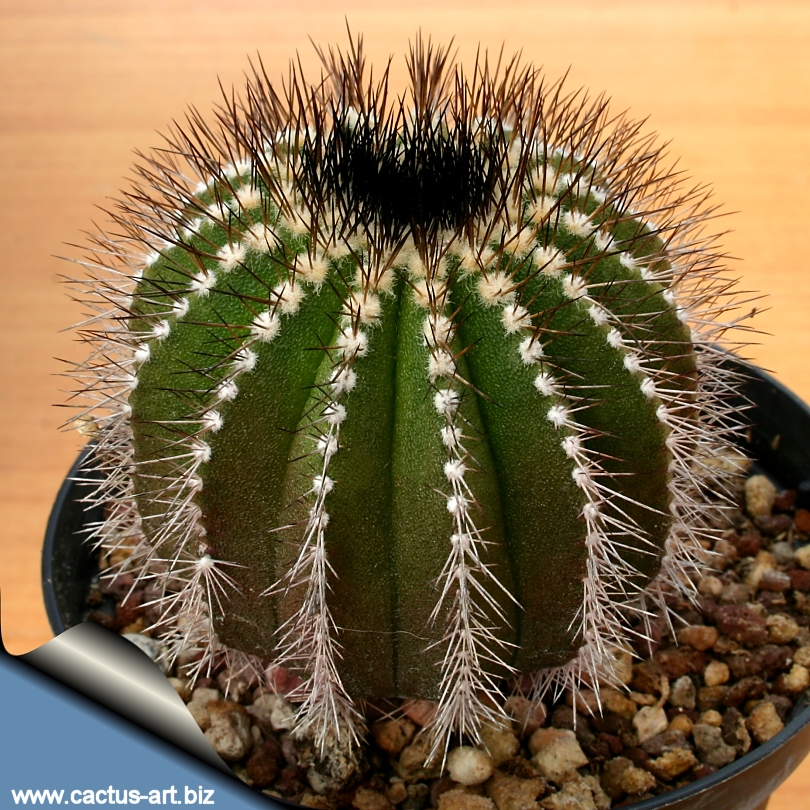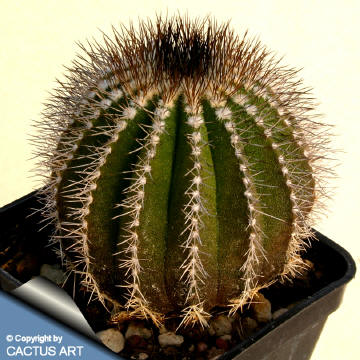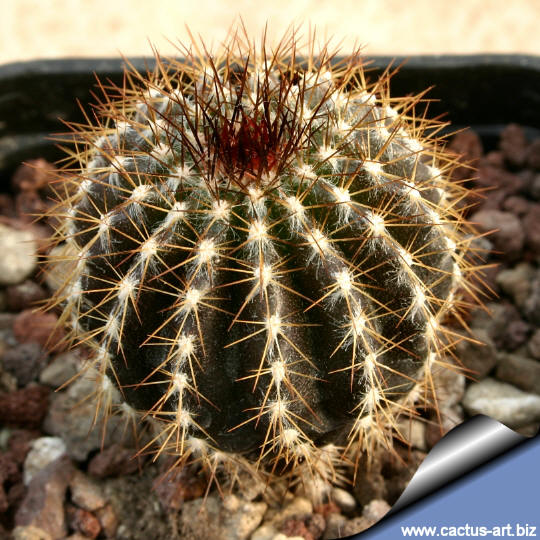|
|
|

Ubelmannia pectinifera multicostata
|

This is one of the most beautiful cactus
and is worth
a place in any collection. |
Description: This cactus normally has a
solitary body
Stem: Although usually globular or slightly elongated in
cultivation, it is reported to grow to as much as 800mm tall and 10-15
cm wide. It is dark reddish-green to reddish-brown with what looks like
a waxy coating covered with pores and if looked at close has a strange
resemblance to human skin. (In cultivation the colour of the plants
depends on sun exposure, the plants grown in shadow are green with white
stripes, wile the ones in full sun take a dark frost brown or purple
color)
Ribs: 15 to 18 vertical and prominent.
Areoles: Set closely to form an almost continuous felty line down
the ribs sides.
Central spines: Dark brown/grey 1 to 4, up to 1.5 (-2) cm long,
the spines are close set neatly arranged straight and give a comb-like
effect.
Radial spines: Absent.
Flowers: Diurnal, funnel-shaped greenish yellow. They are 15 mm
long, 12 mm in diameter, with no discernible scent.
Blooming season: Flowers come sporadically from Early Summer to
Late Summer
Fruit: Inconspicuous , dark red and globular. |
|
|
|
Cultivation: This tropical cactus prefers loves warm moist, humid
conditions and mist spraying is a must in summer. Water regularly during
the growing season and use a very draining mineral potting substrate. At
the onset of winter, do not water. Uebelmannias need heat all year round
and extra winter heat, minimum 10C is best. Avoid any frost. Keep cool
in summer. This plant prove to be root prone if kept too cold in winter.
To help stop this a good deep collar of pumice or lava grit is an
excellent idea. It prefers a full sun position and possibly afternoon
shade in summer. If you can place it so that this occurs the plant will
be much happier.
Propagation: Seeds, but plants are often grafted making them
easier to grow, particularly through the winter. If possible using
a rootstock that is more hardy than the Uebelmannia is the ideal.
Advertising |
|
|
|
|
Family:
Cactaceae (Cactus
Family)
Scientific name: Uebelmannia
pectinifera var. multicostata Buining & Brederoo
Origin: Brazil (mountain of Minas Gerais)
Habitat: The plants are found growing in dry savanna and
rocky areas in rocks cracks or in pockets or small flat areas of organic
leaf mould and sand found among rocks at about 1000m altitude. I
Conservation status: Listed in
CITES appendix 1.
Etymology: Named after Werner Uebelmann, the Swiss nurseryman
who imported them into Europe.
|
|

A young specimen.
|
|
|
|
|
|
Photo of conspecific
taxa, varieties, forms and cultivars of
plants belonging to the Uebelmannia
pectinifera
complex
(This
Taxon has lots of synonyms ( like
many other cacti) with several controversial
varieties and subspecies, and comprises a
multitude of different forms, but where each form is linked to others by
populations of plants with intermediate characteristics):
|
|